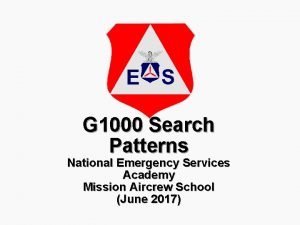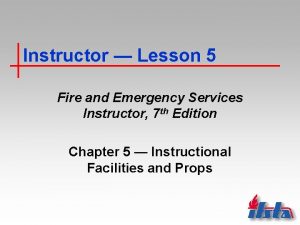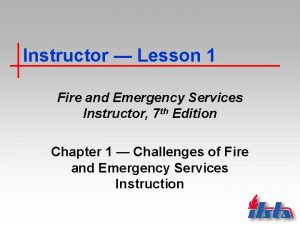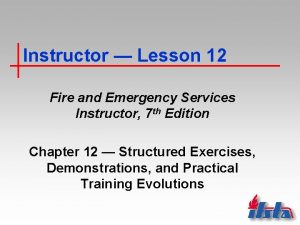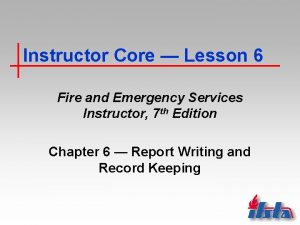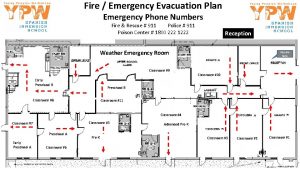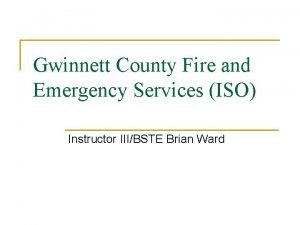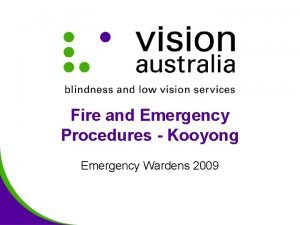Instructor Lesson 4 Fire and Emergency Services Instructor




































- Slides: 36

Instructor — Lesson 4 Fire and Emergency Services Instructor, 7 th Edition Chapter 4 — Effective Interpersonal Communication

Learning Objectives 1. Identify facts about the elements of interpersonal communication. 2. List the purposes of interpersonal communication. 3. Identify facts about the verbal component of interpersonal communication. (Continued) Instructor 4– 1

Learning Objectives 4. List verbal skills improvement guidelines. 5. Describe the main elements of kinesics. 6. Identify guidelines for improving nonverbal communication. (Continued) Instructor 4– 2

Learning Objectives 7. Identify components of the listening process. 8. Identify ways to improve listening skills. Instructor 4– 3

Interpersonal Communication • Consists of: – Casual language – Casual nonverbal clues – Frequent changes of the speaker and listener roles – Spontaneity Instructor 4– 4

Elements of Interpersonal Communication • • • Sender Message Medium or channel Receiver Feedback to the sender Interference (Continued) Instructor 4– 5

Elements of Interpersonal Communication • Sender—Originates a message by encoding or turning thoughts and mental images into words • Message—Elements may by auditory, visual, tactile, olfactory, gustatory (tasted), gestural (a motion), or a combination of these items (Continued) Instructor 4– 6

Elements of Interpersonal Communication • Medium or channel—Path that the message takes between the sender and receiver (Continued) Instructor 4– 7

Elements of Interpersonal Communication • Medium or channel – Usually face-to-face – Often conveyed by other means – Clear-text is preferred approach to radio communication (Continued) Instructor 4– 8

Elements of Interpersonal Communication • Receiver—Receives the message and decodes or interprets it; frame of reference depends on: – Education – Cultural background – Perception – Attitude – Context Instructor 4– 9 (Continued)

Elements of Interpersonal Communication • Feedback—The response is important to the continuation of the conversation – Message’s effect will be obvious by feedback – When positive, desired result achieved – When negative, confrontation or misinterpretation may result (Continued) Instructor 4– 10

Elements of Interpersonal Communication • Interference—Factors that prevent the receiver from fully receiving a message – Internal – External • Interference is not essential for interpersonal communication to occur Instructor 4– 11

Purposes of Interpersonal Communication • Learning—Acquire knowledge or skills • Relating—Establish or maintain a relationship • Influencing—Control, direct, or manipulate behavior • Playing—Create a diversion and gain pleasure or gratification • Helping—Minister to the needs of another person Instructor 4– 12

Verbal Component • Words are abstract • Instructors must select and use words that accurately symbolize the image they are trying to convey – Be aware of audience or listener – Avoid technical language or fire service jargon when speaking with those outside the profession Instructor 4– 13

Stereotypes • • Gender Ethnicity Age Religion Political association Education Regional background (Continued) Instructor 4– 14

Stereotypes • Avoid words that draw attention to classifications • Use of stereotypes creates perception of hostile work environment • Slurs, innuendos, name calling, and inappropriate jokes and comments are no longer accepted or tolerated. Instructor 4– 15

Verbal Skills Improvement • Engage in dual perspective • Take responsibility for personal feelings and thoughts • Show respect for the feelings and thoughts of the other person • Try to gain accuracy and clarity in speaking (Continued) Instructor 4– 16

Verbal Skills Improvement • Be aware of any special needs of the receiver • Avoid speaking or addressing a problem while angry or emotional Instructor 4– 17

Kinesics • Eye contact—Must be appropriate to the situation, relationship, and culture • Facial expression—Must match verbal message (Continued) Instructor 4– 18

Kinesics • Gestures—Allow listener to understand speaker more clearly Courtesy of MFRI. (Continued) Instructor 4– 19

Kinesics • Posture—Sit or stand erect to convey selfconfidence and authority • Poise—Gained by mastering the skills of interpersonal communication Instructor 4– 20

Improving Nonverbal Communication • Eye contact – Learn to maintain eye contact while speaking – Modify when appropriate • Facial expression—Match the facial expression to the message • Gestures—Identify and control gestures that are annoying or distracting to others (Continued) Instructor 4– 21

Improving Nonverbal Communication • Poise—Create poise by building selfconfidence • Vocal characteristics—Use appropriately • Vocal interferences—Eliminate filler words • Personal appearance—Professional at all times (Continued) Instructor 4– 22

Improving Nonverbal Communication • Touch—become conscious of the effect touch can have on others • Proximity—Be aware of the cultural differences that determine the use of space and apply it appropriately • Use of time—Adjust based on individuals and groups who are being dealt with Instructor 4– 23

Listening Process • Attending – Paying attention to the message – Improving the attending step: – Be ready to listen – Listen to the complete message – Maintain eye contact (Continued) Instructor 4– 24

Listening Process • Understanding – Decoding the message – Organizing the message into a logical pattern – Observing nonverbal clues – Asking questions • Paraphrasing – Restating the message in different words – Use when message is important Instructor 4– 25 (Continued)

Listening Process • Remembering – Critical for message to have correct effect – Repeat information – Take notes – Use mnemonics (Continued) Instructor 4– 26

Listening Process • Evaluating – Critically analyzing message – Separate facts from opinions – Facts—Verifiable data that can support the decision-making process – Opinion—A generalization that may not be verifiable without additional data (Continued) Instructor 4– 27

Listening Process • Responding – Completes the communication process – An exchange of roles has occurred – Needs to be both verbal and nonverbal Instructor 4– 28

Improving Listening Skills • Practice – Take notes – Focus • • Ask questions or paraphrase Remove barriers to listening Identify potential barriers Overcome psychological barriers Instructor 4– 29

Summary • Effective interpersonal communication is vital in fire and emergency services. Interpersonal communication consists of six elements: sender, message, medium or channel, receiver, feedback, and interference. • Purposes of interpersonal communication include learning, relating, influencing, playing, and helping. (Continued) Instructor 4– 30

Summary • Instructors should be aware of their audience and use words appropriately. Instructors should be careful to not use language that stereotypes or is inappropriate. (Continued) Instructor 4– 31

Summary • Kinesics includes eye contact, facial expression, gestures, posture, and poise. The nonverbal element of communication is important and affects how the message is interpreted. • Listening is an active process and individuals must focus on the message and be active participants in the communication process. Instructor 4– 32

Discussion Questions 1. What are the six basic elements of interpersonal communication? 2. What are the five purposes of interpersonal communication? 3. What are some of the ways in which people are stereotyped? (Continued) Instructor 4– 33

Discussion Questions 4. Should an instructor every stereotype people by language or tell inappropriate jokes? Why or why not? 5. What are some guidelines for verbal skills improvement? 6. What are the main elements of kinesics? (Continued) Instructor 4– 34

Discussion Questions 7. What are the components of the listening process? 8. What is the difference between facts and opinions? 9. What is one way to improve listening skills? Instructor 4– 35
 Metropolitan fire and emergency services board
Metropolitan fire and emergency services board Ac 61-65
Ac 61-65 Law enforcement video association
Law enforcement video association Reichstag fire who was the fire starter
Reichstag fire who was the fire starter Alarm
Alarm Fire hose reel signage standards
Fire hose reel signage standards A-e rwi
A-e rwi Fire extinguisher parts
Fire extinguisher parts National emergency services academy
National emergency services academy Onsite emergency plan
Onsite emergency plan Emergency response training services
Emergency response training services Reimage firepower module
Reimage firepower module The virtual instructor elements of art
The virtual instructor elements of art Code standards and practices 1 lesson 1
Code standards and practices 1 lesson 1 Participante pasivo
Participante pasivo Tcole instructor course
Tcole instructor course Basic instructor course texas
Basic instructor course texas Basic instructor course texas
Basic instructor course texas Pepperball training manual
Pepperball training manual Everyone selected to serve on this jury
Everyone selected to serve on this jury Instructor vs teacher
Instructor vs teacher Cisco certified trainer
Cisco certified trainer Mptc firearms
Mptc firearms Tcole advanced instructor course
Tcole advanced instructor course Basic instructor course #1014
Basic instructor course #1014 Nfpa 1403
Nfpa 1403 Human factors instructor
Human factors instructor Instructor operating station
Instructor operating station Catia instructor
Catia instructor Instructor
Instructor Tcole 1014 basic instructor course
Tcole 1014 basic instructor course Jrotc marksmanship instructor course online
Jrotc marksmanship instructor course online Nrp instructor toolkit
Nrp instructor toolkit Utp cable
Utp cable Cbrf training registry
Cbrf training registry Nra certified instructor logo
Nra certified instructor logo Naismith was an instructor of
Naismith was an instructor of








